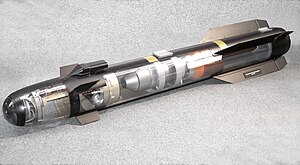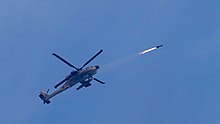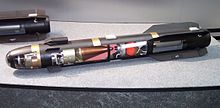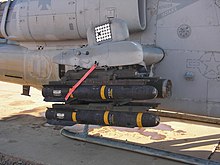avia.wikisort.org - Weapon
The AGM-114 Hellfire is an air-to-ground missile (AGM) first developed for anti-armor use,[6] later developed for precision[7] drone strikes against other target types, especially high-value targets.[8] It was originally developed under the name Heliborne laser, fire-and-forget missile, which led to the colloquial name "Hellfire" ultimately becoming the missile's formal name.[9] It has a multi-mission, multi-target precision-strike ability and can be launched from multiple air, sea, and ground platforms, including the Predator drone. The Hellfire missile is the primary 100-pound (45 kg) class air-to-ground precision weapon for the armed forces of the United States and many other nations. It has also been fielded on surface platforms in the surface-to-surface and surface-to-air roles.[10]
| AGM-114 Hellfire | |
|---|---|
 A model of Longbow Hellfire's components | |
| Type | Air-to-surface and surface-to-surface missile |
| Place of origin | United States |
| Service history | |
| In service | 1984–present |
| Wars | War on Terror |
| Production history | |
| Manufacturer | Lockheed Martin, Boeing (prior second source), and Northrop Grumman (seeker only for AGM-114L Longbow Hellfire) |
| Unit cost | US$150,000[1]
(FY 2021) US$117,000 (FY2017)[2] |
| Produced | 1974–present |
| Specifications | |
| Mass | 100–108 lb (45–49 kg)[3] |
| Length | 64 in (1.6 m) |
| Diameter | 7 in (180 mm) |
| Warhead |
|
| Engine | Thiokol TX-657[4][5] Solid-fuel rocket |
| Wingspan | 13 in (0.33 m) |
| Propellant | APC/HTPB |
Operational range | 550 to 12,030 yd (0.5 to 11 km) |
| Maximum speed | Mach 1.3 (995 mph, 1,601 km/h) |
Guidance system |
|
Launch platform | Rotary- and fixed-wing aircraft, unmanned combat aerial vehicles, tripods, ships, ground vehicles |
Description
Most variants are laser-guided, with one variant, the AGM-114L "Longbow Hellfire", being radar-guided.[11][12] Laser guidance can be provided either from the launcher, such as the nose-mounted opto-electronics of the AH-64 Apache attack helicopter, other airborne target designators or from ground-based observers, the latter two options allowing the launcher to break line of sight with the target and seek cover.[13]
The development of the Hellfire Missile System began in 1974 with the United States Army requirement for a "tank-buster", launched from helicopters to defeat armored fighting vehicles.[14][15][unreliable source?]
The Hellfire II, developed in the early 1990s is a modular missile system with several variants, and entered service with the U.S. Army in 1996.[16] Hellfire II's semi-active laser variants—AGM-114K high-explosive anti-tank (HEAT), AGM-114KII with external blast fragmentation sleeve, AGM-114M (blast fragmentation), and AGM-114N metal augmented charge (MAC)—achieve pinpoint accuracy by homing in on a reflected laser beam aimed at the target. The General Atomics MQ-1 Predator and MQ-9 Reaper unmanned combat aerial vehicles (UCAVs) carry the Hellfire II, but the most common platform is the AH-1Z Viper helicopter gunship, which can carry up to 16 of them. The AGM-114L, or Longbow Hellfire, is a fire-and-forget weapon: equipped with a millimeter-wave (MMW) active radar homing, it requires no further guidance after launch—even being able to lock on to its target after launch[17]—and can hit its target without the launcher or other friendly unit being in line of sight of the target. It also works in adverse weather and battlefield obscurants, such as smoke and fog, which can mask the position of a target or prevent a designating laser from forming a detectable reflection. Each Hellfire weighs 47 kilograms (104 lb), including the 9 kilograms (20 lb) warhead, and has a range of 7.1–11 kilometres (4.4–6.8 mi) depending on trajectory.[18]
The AGM-114R "Romeo" Hellfire II entered service in late 2012. It uses a semi-active laser homing guidance system and a K-charge multipurpose warhead[19][20] to engage targets that formerly needed multiple Hellfire variants. It will replace AGM-114K, M, N, and P variants in U.S. service.[21]
In October 2012, the U.S. ordered 24,000 Hellfire II missiles, for both the U.S. armed forces and foreign customers.[22]
A possible new JCM successor called the Joint Air to Ground Missile (JAGM) is under consideration. Due to budget reductions, JAGM development was separated into increments, with increment 1 focusing on adding a millimeter-wave radar to the Hellfire-R to give it a dual-mode seeker, enabling it to track moving targets in bad weather.[23][24]
Operational history
![M1A1 Abrams main battle tank destroyed by friendly fire in 1991 Gulf War; one Abrams is thought to have been accidentally set on fire by a Hellfire missile fired from an Apache helicopter.[25]](http://upload.wikimedia.org/wikipedia/commons/thumb/5/50/Destroyed_M1A1_Abrams.jpg/220px-Destroyed_M1A1_Abrams.jpg)
In 2009, the British Ministry of Defence (MoD) acknowledged that Army Air Corps (AAC) AgustaWestland Apaches had used AGM-114 Hellfire missiles against Taliban forces in Afghanistan. The MoD stated that 20 missiles were used in 2008 and a further 20 in 2009. In the British Parliament, Liberal Democrat politician Nick Harvey argued that the "Parliament must be reassured these are a weapon of last resort."[26]
AGM-114 Hellfire missiles were been used to kill Hamas leader Ahmed Yassin by the Israeli Air Force (IAF) in 2004,[27][28] and by the US military to kill American-born Islamic cleric Anwar al-Awlaki in Yemen in 2011,[29] Al-Qaeda operative Abu Yahya al-Libi in Pakistan in 2012, al-Shabaab militant Mukhtar Abu Zubair in Somalia in 2014,[30] and British-born ISIL executioner Mohammed Emwazi (also known as "Jihadi John") in Syria in 2015.[31]
The AGM-114 has occasionally been used as an air-to-air missile. The first operational air-to-air kill with a Hellfire took place on 24 May 2001, after a civilian Cessna 152 aircraft entered Israeli airspace from Lebanon, with unknown intentions and refusing to answer or comply with ATC repeated warnings to turn back. An Israeli Air Force AH-64A Apache helicopter fired on the Cessna, resulting in its complete disintegration.[32][33] The second operational air-to-air kill with a Hellfire occurred on 10 February 2018, after an Iranian UAV entered Israeli airspace from Syria. An Israeli Air Force AH-64 launched a Hellfire missile at the UAV, successfully destroying it.[34][third-party source needed]
In January 2016 The Wall Street Journal reported that one training missile without a warhead was accidentally shipped to Cuba in 2014 after a training mission in Europe;[35] it was later returned.[36] A US official said that this was an inert "dummy" version of the Lockheed system stripped of its warhead, fuse, guidance equipment and motor, known as a "Captive Air Training Missile".[37][38]
Variants
This section needs additional citations for verification. (January 2016) |


- AGM-114A[39]
-
- Produced: 1982–1992
- Target: Armored vehicles
- Range: 8,000 m (8,700 yd)
- Guidance:
- Semi-active laser homing (SALH)
- Non-programmable. Analogue autopilot.
- Warhead: 8 kg (18 lb) shaped charge HEAT. Unable to penetrate reactive armor.
- Length: 163 cm (64 in)
- Weight: 45 kg (99 lb)
- AGM-114B/C
-
- Produced: 1982–1992
- Target: Armored vehicles, ship-borne targets
- Range: 8,000 m (8,700 yd)
- Guidance:
- Semi-active laser homing (SALH)
- Non-programmable
- Analogue autopilot
- Warhead: 8 kg (18 lb) shaped charge HEAT. Unable to penetrate reactive armor.
- Length: 163 cm (64 in)
- Weight: 45 kg (99 lb)
- AGM-114F/FA Interim Hellfire
- AGM-114K/K2/K2A Hellfire II
-
- Produced: since 1993
- Target: All armored targets
- Range: 11,000 m (12,000 yd)
- Guidance:
- Semi-active laser homing with electro-optical countermeasures hardening
- Digital autopilot & electronics improvements allow target reacquisition after lost laser lock
- Warhead: 9 kg (20 lb) tandem shaped charge HEAT
- Length: 163 cm (64 in)
- Weight: 45 kg (99 lb)
- K-2 adds insensitive munitions (IM)
- K-2A adds blast-fragmentation sleeve
- AGM-114L Hellfire LongBow
-
- Produced: 1995–2005
- Target: All armored targets
- Range: 8,000 m (8,700 yd)
- Guidance:
- Fire and forget millimeter-wave (MMW) radar seeker coupled with inertial guidance
- Homing capability in adverse weather and the presence of battlefield obscurants
- Programmable fusing and guidance
- Warhead: 9 kg (20 lb) tandem shaped charge high-explosive anti-tank (HEAT) insensitive munitions (IM) warhead
- Length: 180 cm (71 in)
- Weight: 49 kg (108 lb)
- L-7/8A Counter-UAS/counter-littoral variants with proximity fuze and blast-fragmentation sleeve[42]
- AGM-114M Hellfire II (Blast Frag)
-
- Produced: 1998–2010
- Target: Bunkers, light vehicles, urban (soft) targets and caves
- Range: 11,000 m (12,000 yd)
- Guidance:
- Semi-active laser homing
- Delayed and programmable fusing in for hardened targets
- Warhead: Blast fragmentation/incendiary
- Weight: 49 kg (108 lb)
- Length: 180 cm (71 in)
- AGM-114N Hellfire (MAC)[43]

Hellfire II missile exposed through a transparent casing, showing laser homing guidance system in front, copper cone shaped charge explosive in middle, propulsion in rear - Produced: since 2003
- Target: Buildings, soft-skinned targets, ship-borne targets
- Range: 11,000 m (12,000 yd)
- Guidance:
- Semi-active laser homing
- Millimeter-wave radar seeker
- Warhead: Metal augmented charge, sustained pressure wave with delayed fuse capability
- Weight: 48 kg (106 lb)
- Speed: Mach 1.3 (1,600 km/h)
- Diameter: 180 mm (7.1 in)
- Wingspan: 0.33 m (13 in)
- Length: 1.63 m (5 ft 4 in)
- AGM-114P/P+ Hellfire II (For UAS)
-
- Produced: 2003–2012
- Target: All surface targets
- Range: 11,000 m (12,000 yd)
- Guidance:
- Semi-active laser homing
- Delayed and programmable fusing in for hardened targets
- Warhead: Shaped Charge or Blast Fragmentation
- Weight: 49 kg (108 lb)
- Length: 180 cm (71 in)
- Designed for UAV altitudes
- P-2A adds steel fragmentation sleeve
- P-2B adds tantalum fragmentation sleeve
- P+ Adds enhanced inertial measurement unit (IMU) and software support, many customizations for varying battlefields.
- AGM-114R Hellfire II (Hellfire Romeo)[44]
-
- Produced: since 2012
- Target: All targets
- Range: 11,000 m (12,000 yd)
- Guidance:
- Semi-active laser homing
- Warhead: Multi-function warhead, reduced net explosive weight for low collateral damage (R-9E and R-9H).
- Weight: 49 kg (108 lb)
- Speed: Mach 1.3
- Length: 180 cm (5 ft 11 in)[39]
- Unit Cost: $99,600 (all-up round, 2015 USD)[45]
- M36 Captive Flight Training Missile
- The M36 is an inert device used for training in the handling of the Hellfire. It includes an operational laser seeker.[46]
- AGM-114R9X
- The Hellfire R9X is a Hellfire variant with a kinetic warhead with pop-out blades instead of explosives, used against specific human targets. Its lethality is due to 45 kg (100 lb) of dense material with six blades flying at high speed, to crush and cut the targeted person[47]— the R9X has also been referred to as the 'Ninja Missile'[48] and 'Flying Ginsu'.[47] It is intended to reduce collateral damage when targeting specific people.[49] Deployed in secret in 2017, its existence has been public since 2019. This variant was used in the killing in 2017 of Abu Khayr al-Masri, a member of Al-Qaeda's leadership, and in 2019 of Jamal Ahmad Mohammad Al Badawi, accused mastermind of the 2000 USS Cole bombing.[50][51] The weapon has also been used in Syria,[52] and in Afghanistan against a Taliban commander.[53][54] It was used twice in 2020 against senior al-Qaeda leaders in Syria; in September 2020 US officials estimated that it had been used in combat around six times.[55][56][57][58][59]
- Hellfire missiles fired by a Reaper drone[60] were used on 31 July 2022 to kill Ayman al-Zawahiri,[7] the leader of Al-Qaeda, who had formerly been involved in planning the 9/11 and other attacks on US targets. It was reported that the missile hit him on a balcony, causing minimal collateral damage. Reports stress that avoiding other casualties was a priority for the mission, following drone attacks that killed several uninvolved people, attracting much criticism. It is widely thought that the Hellfires were the R9X variant, but a United States Special Operations Command spokesman declined to comment, while confirming that the R9X was "in US Special Operations Command's munitions inventory".[61][62]
Launch vehicles and systems
Manned helicopters

- AH-64 Apache[63]
- AH-6
- MH-6 Little Bird
- AH-1Z Viper
- Bell OH-58 Kiowa
- Tiger ARH
- MH-60R
- MH-60S
Fixed-wing aircraft

- Beechcraft Super King Air[64]
- Cessna AC-208 Combat Caravan[65]
- KC-130J Harvest HAWK[66]
- IOMAX Archangel[67][68]
- AC-130W[69]
- MQ-1 Predator
- MQ-1C Gray Eagle
- MQ-9 Reaper
Vessels

- Super Dvora Mk III-class patrol boat, Israel[70]
- Freedom-class littoral combat ship
- Independence-class littoral combat ship
Ground vehicles
Experimental platforms
The system has been tested for use on the Humvee and the Improved TOW Vehicle (ITV). Test shots have also been fired from a C-130 Hercules. Sweden and Norway use the Hellfire for coastal defense and have conducted tests with Hellfire launchers mounted on the Combat Boat 90 coastal assault boat.[71]
The US Navy was evaluating the missile for use on the Freedom-class littoral combat ship and Independence-class littoral combat ship from 2014.[72] The missile was successfully fired from a LCS in early 2017[73] This system is set to deploy by late 2019.[74]
In 2016 the Longbow Hellfire was tested by the US Army using a 15-tube Multi-Mission Launcher mounted on a Family of Medium Tactical Vehicles (FMTV) truck. The MML is an Army-developed weapon system capable of deploying both surface-to-surface and surface-to-air missiles.[75]
Operators

The following nations use the Hellfire:[76]
 Australia
Australia Croatia
Croatia Egypt
Egypt France
France Greece[77]
Greece[77] India
India Indonesia
Indonesia Iraq
Iraq Israel
Israel Italy
Italy Jordan
Jordan Morocco
Morocco Japan
Japan Kuwait
Kuwait Lebanon[78]
Lebanon[78] Netherlands
Netherlands Norway
Norway Pakistan
Pakistan Qatar
Qatar South Korea
South Korea Saudi Arabia
Saudi Arabia Singapore
Singapore Spain
Spain Sweden
Sweden Taiwan (Republic of China)
Taiwan (Republic of China) Tunisia[79]
Tunisia[79] Turkey
Turkey Ukraine[80]
Ukraine[80] United Arab Emirates
United Arab Emirates United Kingdom
United Kingdom United States
United States
See also
- 9M120 Ataka
- AGM-169 Joint Common Missile
- AGM-176 Griffin
- Barq
- Brimstone (missile)
- Direct Attack Guided Rocket
- HJ-10
- List of missiles
- Mokopa
- Nag (missile)
- PARS 3 LR
- Spike (missile)
- UMTAS
- United States Army Aviation and Missile Command
References
- "Ultimate Guide on AGM-114 Hellfire Missile: Capabilities, Variants, and Cost". The Defense Post. 22 March 2021.
- "United States Department Of Defense Fiscal Year 2017 Budget Request Program Acquisition Cost By Weapon System" (PDF). Office of the Under Secretary of Defense (Comptroller)/Chief Financial Officer. January 2016. p. 58. Archived (PDF) from the original on 1 December 2017. Retrieved 18 November 2017.
- AGM-114 Hellfire Variants Archived 1 March 2009 at the Wayback Machine. GlobalSecurity.org, 25 November 2005. Retrieved 14 August 2009.
- Parsch, Andreas. "Boeing/Lockheed Martin (Rockwell/Martin Marietta) AGM-114 Hellfire". Directory of U.S. Military Rockets and Missiles.
The AGM-114B also introduced the Thiokol TX-657 (M120E1) reduced-smoke rocket motor.
- Spring 2014 Industry Study (PDF), National Defence University, Fort McNair, Washington, DC, p. 10, archived (PDF) from the original on 9 October 2022,
The component that ... propels the Hellfire is the Thiokol TX-657.
- "AGM-114 Hellfire". Military.com. Retrieved 26 July 2020.
- "Ayman al-Zawahiri: Taking down a terrorist". The Times of India. India. 3 August 2022. Retrieved 3 August 2022.
- Hallion, Richard P. (2018). "Chapter 4: Science, Technology and Air Warfare". In Olsen, John Andreas (ed.). Routledge Handbook of Air Power. Routledge. p. 52. ISBN 978-1-315-20813-8.
- "World Missile Yearbook". Archived from the original on 16 February 2017. Flight International, 14 March 1974.
- J. FREEDBERG JR., SYDNEY (10 July 2018). "Army Anti-Aircraft Stryker Can Kill Tanks Too". breakingdefense.com. Breaking Defense. Retrieved 1 July 2021.
- "Longbow Hellfire". Archived from the original on 13 October 2011. Retrieved 27 September 2011.
- "AGM-114L Longbow Missile". (shows that the L variant is called Longbow). Archived from the original on 20 March 2012. Retrieved 27 September 2011.
- "AGM-114 Hellfire Modular Missile System (HMMS)". Archived from the original on 13 October 2011. Retrieved 27 September 2011.
- John Pike. "AGM-114 Hellfire Modular Missile System (HMMS)". Archived from the original on 6 April 2015. Retrieved 6 February 2015.
- "Introduction of the Hellfire – A Revolutionary Weapon to defeat the Soviet Armor Threat". Archived from the original on 31 January 2009.. Official US Army video at Real Military Flix.
- "Hellfire". Redstone Arsenal Historical Information.
- "AGM-114L Longbow Missile". Archived from the original on 20 March 2012. Retrieved 27 September 2011.
- "AGM-114 Hellfire II Missile". Army Technology. Archived from the original on 20 April 2019. Retrieved 20 April 2019.
- "Multi-Purpose Shaped Charge Warheads". General Dynamics Ordinance and Tactical Systems. Archived from the original on 27 July 2018. Retrieved 27 July 2018.
- "K-charge—a multipurpose shaped charge warhead". Google patents. Retrieved 27 July 2018.
- Army and Lockheed Martin prepare for production of advanced laser-guided Hellfire missile. Archived 24 May 2014 at the Wayback Machine - Militaryaerospace.com, 10 April 2012.
- Hella Lotta Hellfires. Archived 21 October 2012 at the Wayback Machine. Strategypage.com, 19 October 2012.
- Army Reduces Scope Of Tri-Mode JAGM. Archived 20 May 2014 at the Wayback Machine. Aviation Week, 27 August 2012.
- "Hellfire Replacement Step Closer With Draft JAGM RFP". Aviationweek.com. Archived from the original on 26 August 2014.
- "Operation Desert Storm: Investigation of a U.S. Army Fratricide Incident" (PDF). Govinfo. GAO/OSI-95-10. U.S. Government Printing Office. General Accounting Office. 7 April 1995. Archived (PDF) from the original on 9 October 2022.
- Norton-Taylor, Richard (28 May 2009). "MoD admits use of controversial 'enhanced blast' weapons in Afghanistan". The Guardian. Retrieved 9 November 2022.
- Whitaker, Brian (23 March 2004). "Assassination method: surveillance drone and a Hellfire missile". The Guardian. London. Archived from the original on 28 August 2013. Retrieved 4 December 2010.
- "The Life And Death of Shaikh Yasin". Al Jazeera. 25 March 2004. Archived from the original on 16 August 2007. Retrieved 20 October 2010.
- Kasinoff, Laura; Mazzetti, Mark; Cowell, Alan (30 September 2011). "U.S.-Born Qaeda Leader Killed in Yemen". The New York Times. Archived from the original on 19 March 2017. Retrieved 26 February 2017.
- Martinez, Michael (5 September 2014). "Top Somali militant killed in U.S. operation, Pentagon says". CNN. Archived from the original on 5 September 2014. Retrieved 5 September 2014.
- "How the US and UK tracked down and killed Jihadi John". The Telegraph. 13 November 2015. Archived from the original on 13 February 2018. Retrieved 4 April 2018.
- "מטוס ססנה לבנוני הופל מעל מכמורת" [Lebanese Cessna shot down over Mikhmoret] (in Hebrew). Ynet. Archived from the original on 6 February 2015. Retrieved 6 February 2015.
- "Israel shoots down Lebanese civilian plane". CNN. Retrieved 1 July 2021.
- "Iranian UAV Intercepted by an Israeli Helicopter". Israel Defense Forces. 10 February 2018. Archived from the original on 10 February 2018. Retrieved 10 February 2018.
- Devlin Barrett, Gordon Lubold. "Missing U.S. Missile Shows Up in Cuba". Archived 4 March 2017 at the Wayback Machine. The Wall Street Journal, 8 January 2016.
- Klapper, Bradley (13 February 2016). "Cuba Returns Dummy Hellfire Missile Mistakenly Received". ABC News. Archived from the original on 13 February 2016. Retrieved 1 October 2017.
- "Dummy US missile disappears, turns up in Cuba". Yahoo News. 8 January 2016. Archived from the original on 5 March 2016. Retrieved 14 January 2017.
- "Hellfire Missile Wrongly Sent To Cuba Was Inert, U.S. Official Says". NPR. 8 January 2016. Archived from the original on 30 March 2018. Retrieved 4 April 2018.
- "Hellfire Family of Missiles" (PDF). Archived (PDF) from the original on 9 October 2022.
- "AGM-114 Hellfire". Weaponsystems.
- "AGM-114 Hellfire Variants". GlobalSecurity.
- Warnick, David. "Program Executive Office Missiles and Space" (PDF). PEO Missiles and Space, US Army. Archived (PDF) from the original on 24 April 2021.
- "AGM-114N Hellfire". Archived from the original on 5 August 2020. Retrieved 5 August 2020.
- "Lockheed Martin Distribution Statement" (PDF). US Army. Archived from the original (PDF) on 22 July 2015. Retrieved 20 August 2015.
- "AGM-114 Hellfire Missile". AeroWeb. Archived from the original on 12 October 2015. Retrieved 29 October 2015.
- John Pike. "FM 1-140 Chapter 5". GlobalSecurity.org. Archived from the original on 14 September 2015. Retrieved 11 September 2015.
- Beaumont, Peter (25 September 2020). "US military increasingly using drone missile with flying blades in Syria". The Guardian. Archived from the original on 25 September 2020.
- "Six-bladed 'ninja missile' US used to kill Bin Laden's deputy Ayman al-Zawahiri". The Independent. 2 August 2022. Retrieved 2 August 2022.
- Trevithick, Joseph (9 May 2019). "Secret Hellfire Missile With Sword-Like Blades Made Mysterious Strike On Terror Leader in Syria". The War Zone. The Drive.
- Lubold, Gordon; Strobel, Warren P. (9 May 2019). "Secret U.S. Missile Aims to Kill Only Terrorists, Not Nearby Civilians". The Wall Street Journal. ISSN 0099-9660. Archived from the original on 9 May 2019. Retrieved 10 May 2019.
- Gallagher, Sean (9 May 2019). "Drones used missiles with knife warhead to take out single terrorist targets". Ars Technica. Archived from the original on 10 May 2019. Retrieved 10 May 2019.
- Schmitt, Eric (24 June 2020). "U.S. Used Missile With Long Blades to Kill Qaeda Leader in Syria". The New York Times. Archived from the original on 25 June 2020. Retrieved 6 October 2022.
- Trevithick, Joseph (3 December 2019). "Another Syrian Terrorist Seemingly Killed By Hellfire Missile With Pop-Out Sword Blades (Updated)". The War Zone. The Drive.
- Rogoway, Tyler (12 January 2020). "America's Shadowy Sword Wielding Hellfire Missile Has Migrated To The Afghan Battlefield". The War Zone. The Drive.
- Schmitt, Eric (24 September 2020). "U.S. Commandos Use Secretive Missiles to Kill Qaeda Leaders in Syria". The New York Times. Archived from the original on 24 September 2020. Retrieved 25 September 2020.
- "M299/M310 Hellfire Longbow Missile Launcher for rotary wing aircraft".
- "AGM-114N Hellfire". Royal Australian Navy. Retrieved 29 August 2022.
- "AGM-114 Hellfire Missile Ultimate Guide: Capabilities, Variants, and Cost". 22 March 2021.
- "US Hellfire Missile Orders, FY 2011-2020". Defense Industry Daily.
- Pilkington, Ed (3 August 2022). "How Ayman al-Zawahiri's 'pattern of life' allowed the US to kill al-Qaida leader". The Guardian.
- Stone, Mike; Ali, Idrees (3 August 2022). "Little-known modified Hellfire missiles likely killed al Qaeda's Zawahiri". Reuters.
- "Explained: All about Hellfire R9X – the drone missile with razor-sharp blades used to kill al-Zawahiri". The Indian Express. 2 August 2022. Retrieved 3 August 2022.
- Apache Guardian set to deploy on May Archived 4 March 2016 at the Wayback Machine - Koreatimes.co.kr, 26 January 2016
- "US sends Hellfire missiles to Iraq". Belfast Telegraph. 27 December 2013. Archived from the original on 28 December 2013. Retrieved 27 December 2013.
- "New Iraqi Airborne Strike Capability Spotted". Aviation Week & Space Technology. 14 October 2008. Archived from the original on 21 May 2011. Retrieved 20 May 2010.
- KC-130J Harvest Hawk takes on new role in Afghanistan Archived 9 December 2010 at the Wayback Machine - DVIDS
- "The Archangel: Crop Duster to Tank Buster". Archived from the original on 5 April 2017. Retrieved 4 April 2017.
- "Come, Gabriel, Blow Your Horn". Archived from the original on 5 April 2017. Retrieved 4 April 2017.
- "The U.S. Air Force's New AC-130 Gunships Are Really Bomb Trucks". FoxTrot Alpha. 1 June 2014. Archived from the original on 6 September 2014. Retrieved 5 September 2014.
- Ahronheim, Anna (30 November 2016). "Israel Navy Debuts New Super Dvora Patrol Craft". The Jerusalem Post. Archived from the original on 2 October 2017. Retrieved 1 October 2017.
- Norwegian article about the experimental deployment of Hellfire missiles on coastal patrol boats (from the official web site of the Norwegian Armed Forces).
- Muñoz, Carlo (14 January 2014). "SNA 2014: Navy Won't Rule Out Army Longbow Hellfire for LCS". news.usni.org. U.S. Naval Institute. Archived from the original on 16 January 2014. Retrieved 14 January 2014.
- United States Naval Institute (13 January 2017). "USS Detroit fires hellfire missiles in first ever test of LCS mission package". USNI News Video. Archived from the original on 11 November 2021. Retrieved 13 January 2017.
- Eckstein, Megan (3 July 2019). "Navy Completed Hellfire Tests on Littoral Combat Ship, Will Likely Deploy Later This Year". USNI. U.S. Naval Institute. Retrieved 26 October 2020.
- Munoz, Carlo. "New army launcher successfully fires Hellfire, Sidewinder missiles". upi.com. United Press International. Archived from the original on 13 November 2018. Retrieved 12 November 2018.
- "AGM-114 Hellfire and Longbow Hellfire", Jane's Weapon Systems, Vol. 1: Air-Launched, 19 March 2013.
- "ЦАМТО / / Lockheed Martin поставит ПТУР AGM-114 "Хеллфайр" СВ США и инозаказчикам". armstrade.org.
- "Heavy U.S. Military Aid to Lebanon Arrives ahead of Elections". Naharnet Newsdesk. 9 April 2009. Archived from the original on 30 November 2009. Retrieved 9 April 2009.
- "Proposed Foreign Military Sale to Tunisia". Archived from the original on 27 July 2014. Retrieved 1 August 2014.
- "Sweden sends anti-ship and anti-tank missiles to Ukraine". The Local. 22 June 2022. Retrieved 5 August 2022.
External links
- AGM-114 Hellfire Archived 8 September 2016 at the Wayback Machine—Federation of American Scientists (FAS)
- HELLFIRE II Missile—Lockheed Martin
- LONGBOW FCR and LONGBOW HELLFIRE Missile—Lockheed Martin
- Designation Systems
- Global Security
- Archived copy of Navy Fact File
- Janes.com
- Hellfire Detailed Description and Images Archived 23 February 2008 at the Wayback Machine
На других языках
[de] AGM-114 Hellfire
Die AGM-114 Hellfire (englisch für ‚Höllenfeuer‘) ist eine US-amerikanische Luft-Boden-Rakete zur Panzerabwehr. In der Grundausführung benutzt die Hellfire ein Laserlenksystem, spätere Versionen verfügen über einen Radarsuchkopf. Hauptplattformen für die Hellfire-Rakete sind die verschiedenen Kampfhubschrauber im Arsenal der US Army. Mit der Hellfire II[2] steht inzwischen eine optimierte Version des ursprünglichen Hellfire-Systems zur Verfügung. Der AH-64 Apache Longbow-D (in der Version mit Radar) kann darüber hinaus auch eine radargelenkte Version der Hellfire abfeuern, die dadurch zu einer echten Fire-and-Forget-Waffe wird, bei der sich unter optimalen Bedingungen der Angreifer dem Ziel noch nicht einmal zeigen muss. Die lasergelenkten Hellfire-Raketen benötigen dagegen spätestens kurz vor dem Einschlag eine Zielbeleuchtung durch einen Laser.- [en] AGM-114 Hellfire
[fr] AGM-114 Hellfire
L'AGM-114 Hellfire (hellfire signifie en français « feu de l'enfer ») est un missile antichar à guidage laser semi-actif, ou à guidage radar (de type tire et oublie) en fonction des versions. Il est fabriqué par l'entreprise de défense américaine Lockheed Martin. Il est principalement utilisé sur les hélicoptères, notamment sur l'AH-64 Apache, mais également sur des drones tels que les MQ-1 Predator et MQ-9 Reaper et, depuis 2017, à bord de navires de guerre. Très polyvalent, il peut être employé contre tout type de véhicule, mais aussi contre des bâtiments. Sa portée relativement longue permet au lanceur de rester à l'abri, voire invisible.[it] AGM-114 Hellfire
L'AGM-114 Hellfire è un missile anticarro, nato per dotare gli elicotteri di capacità d'attacco contro veicoli corazzati. La sigla AGM sta infatti per Air-to-Ground-Missile cioè missile aria-terra mentre l'acronimo HELLFIRE, scelto anche per il suo evocativo significato di "fuoco infernale", sta per HELicopter Launched FIre and foRgEt missile (missile elilanciato spara e dimentica). Le prime versioni non erano effettivamente "spara e dimentica", capacità che è stata raggiunta a partire dalla versione Longbow, con un sistema di guida radar.[ru] AGM-114 Hellfire
AGM-114 «Хеллфайр» (англ. AGM-114 Hellfire, /.mw-parser-output .ts-comment-commentedText{border-bottom:1px dotted;cursor:help}@media(hover:none){.mw-parser-output .ts-comment-commentedText:not(.rt-commentedText){border-bottom:0;cursor:auto}}ˈhɛlfʌɪər/, буквально — «адское пламя», является бэкронимом от Heliborne, Laser, Fire and Forget[2]) — американская ракета класса «воздух-поверхность», с полуактивным лазерным или активным радиолокационным наведением (принцип «выстрелил и забыл»).Другой контент может иметь иную лицензию. Перед использованием материалов сайта WikiSort.org внимательно изучите правила лицензирования конкретных элементов наполнения сайта.
WikiSort.org - проект по пересортировке и дополнению контента Википедии

